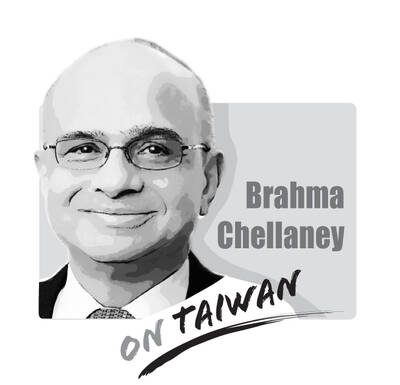During the meeting between Chinese Nationalist Party (KMT) Chairman Lien Chan (
Lien wasn't the first one in Taiwan to publicly drum up the idea of setting up a common market similar to the EU as an institutionalized mechanism for economic and commercial cooperation across the Taiwan Strait. His vice-presidential running mate in the 2000 presidential election, Vincent Siew (
Siew, chairman of the Chung-Hua Institution for Economic Research, believed the common market can serve as a framework for economic cooperation, eventually leading to political integration.
No doubt Siew regards these as very visionary goals. Unfortunately, the prescription by Siew and now by Lien doesn't deal with the central problem. The important questions are, do Taiwan and China share either the basic economic structure or universal principles of the European integration model in terms of democracy, human rights and the rule of law? Also, how will the job get done, given China's insistence upon the "one China" principle and its denial of the sovereign state that Taiwan is?
To be honest, there is no fault with the common-market concept itself. But there does exist a greater difference between the attitudes of China and Taiwan toward a cross-strait common market. For Taiwan, a common market may represent an alternative to unification with China and at the same time a chance to exploit the massive Chinese market. But for China, the cross-strait common-market scenario is nothing but part of its united-front tactics to divide Taiwan as it hopes to achieve its unification goal.
The discussion about forming a common market will probably go nowhere as long as Beijing maintains its precondition for talks -- that Taiwan must recognize the coercive "one China" principle.
So Lien and his party's enthusiasm about the common-market concept may appear one-sided. First of all, the communique did not elaborate on the matter, although Lien later that day said his idea behind the concept was to increase and guarantee investment and trade across the Taiwan Strait. Secondly, he argued that the private sector can begin with economic forum discussions to lay down the foundation for a future common market, if President Chen Shui-bian's (陳水扁) government refuses the idea. Maybe Lien should be reminded of the fact that the issue is dependent on government-to-government talks.
Sure, talks would help. But the solution for breaking the political impasse across the Taiwan Strait doesn't lie in the formation of a common market.
No one can possibly say whether the European model of integration can be transplanted to the two sides of the Strait. But at this point, both sides are members of the World Trade Organization (WTO) and there do exist opportunities that the two countries can talk on the issue of legal protection for businessmen, particularly in such areas as investment guarantees and bankruptcy codes at the world trade body.
The WTO is a non-political and multilateral organization which clearly outlines the rights and obligations of its member nations. As the WTO helps depoliticize disputes by setting out uniform standards, theoretically it should provide a good opportunity for cross-strait talks. But the truth is China still refuses to talk to Taiwan on an equal basis under the WTO framework, so how can we place our hopes for stable political and economic development across the Taiwan Strait on a proposed common-market concept?

Taiwan stands at the epicenter of a seismic shift that will determine the Indo-Pacific’s future security architecture. Whether deterrence prevails or collapses will reverberate far beyond the Taiwan Strait, fundamentally reshaping global power dynamics. The stakes could not be higher. Today, Taipei confronts an unprecedented convergence of threats from an increasingly muscular China that has intensified its multidimensional pressure campaign. Beijing’s strategy is comprehensive: military intimidation, diplomatic isolation, economic coercion, and sophisticated influence operations designed to fracture Taiwan’s democratic society from within. This challenge is magnified by Taiwan’s internal political divisions, which extend to fundamental questions about the island’s identity and future
Media said that several pan-blue figures — among them former Chinese Nationalist Party (KMT) chairwoman Hung Hsiu-chu (洪秀柱), former KMT legislator Lee De-wei (李德維), former KMT Central Committee member Vincent Hsu (徐正文), New Party Chairman Wu Cheng-tien (吳成典), former New Party legislator Chou chuan (周荃) and New Party Deputy Secretary-General You Chih-pin (游智彬) — yesterday attended the Chinese Communist Party’s (CCP) military parade commemorating the 80th anniversary of the end of World War II. China’s Xinhua news agency reported that foreign leaders were present alongside Chinese President Xi Jinping (習近平), such as Russian President Vladimir Putin, North Korean leader Kim
Taiwan People’s Party (TPP) Chairman Huang Kuo-chang (黃國昌) is expected to be summoned by the Taipei City Police Department after a rally in Taipei on Saturday last week resulted in injuries to eight police officers. The Ministry of the Interior on Sunday said that police had collected evidence of obstruction of public officials and coercion by an estimated 1,000 “disorderly” demonstrators. The rally — led by Huang to mark one year since a raid by Taipei prosecutors on then-TPP chairman and former Taipei mayor Ko Wen-je (柯文哲) — might have contravened the Assembly and Parade Act (集會遊行法), as the organizers had
Minister of Foreign Affairs Lin Chia-lung (林佳龍) last week made a rare visit to the Philippines, which not only deepened bilateral economic ties, but also signaled a diplomatic breakthrough in the face of growing tensions with China. Lin’s trip marks the second-known visit by a Taiwanese foreign minister since Manila and Beijing established diplomatic ties in 1975; then-minister Chang Hsiao-yen (章孝嚴) took a “vacation” in the Philippines in 1997. As Taiwan is one of the Philippines’ top 10 economic partners, Lin visited Manila and other cities to promote the Taiwan-Philippines Economic Corridor, with an eye to connecting it with the Luzon